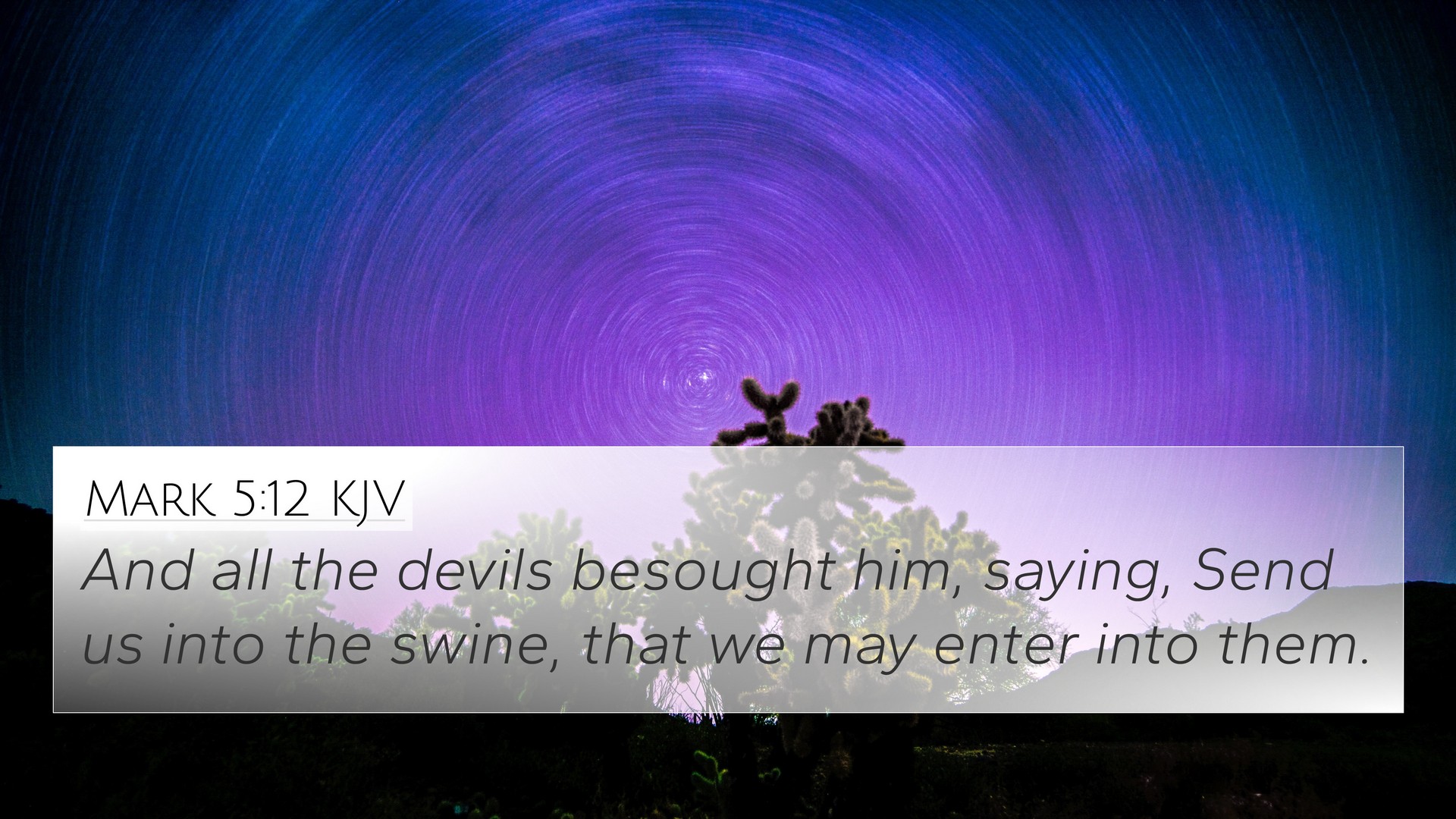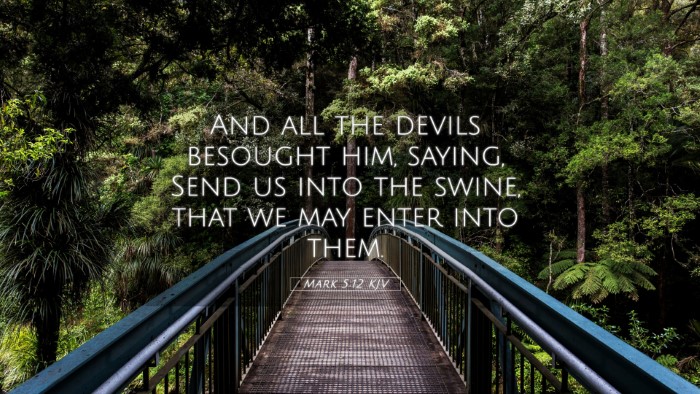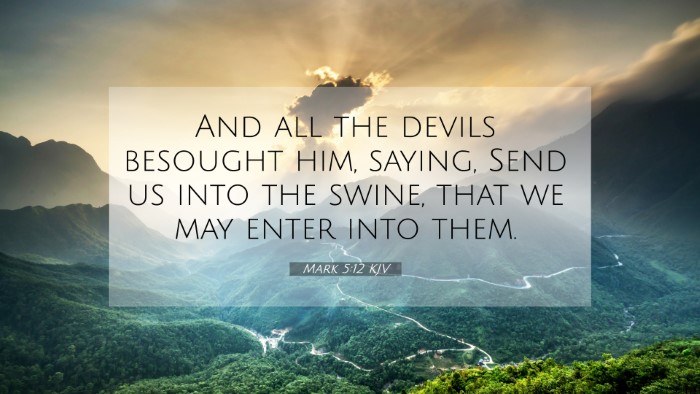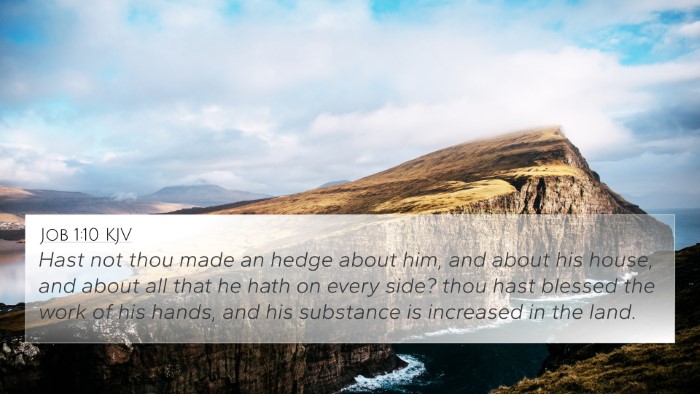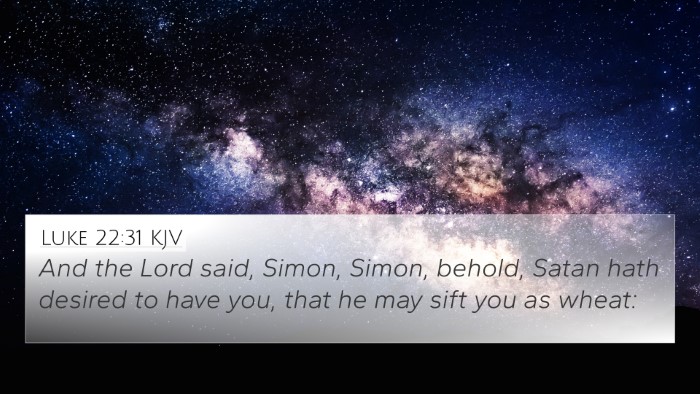Understanding Mark 5:12
Mark 5:12 records a critical moment in the narrative of the demoniac who encounters Jesus. The verse states:
"And all the devils besought him, saying, Send us into the swine, that we may enter into them."
This verse illustrates the power dynamic between Jesus and the forces of evil, highlighting several key theological and moral themes.
Context of the Verse
The context surrounding Mark 5:12 is vital to fully grasping its significance. Jesus had just crossed over into the region of the Gerasenes, where he encountered a man possessed by many demons. This man lived among the tombs and was bound by chains, indicative of his tormented state.
Insights from Commentaries
-
Matthew Henry notes that the plea of the demons to enter the swine reveals their understanding of their state and their desire to continue their influence over creation. The request highlights the profound sorrow of their existence.
-
Albert Barnes indicates that their asking to enter the swine illustrates their wickedness and defiance. It signifies their unwillingness to accept being cast out without a place to go, demonstrating their continuous pursuit of earthly vessels to inhabit and corrupt.
-
Adam Clarke emphasizes the symbolic significance of swine in Jewish culture, often viewed as unclean animals. This suggests that the demons would rather inhabit unclean creatures than be cast into the abyss, indicating their persistent rebellion against God’s order.
Theological Themes
Mark 5:12 serves as a focal point to explore several theological themes:
-
The Nature of Evil: The demons' request reflects the persistent nature of evil in seeking attachments to physical forms.
-
Authority of Christ: This narrative demonstrates Jesus’ supreme authority over demonic forces, establishing a clear contrast between His holiness and the unclean spirits.
-
Redemptive Power: The act of Jesus casting out these demons serves as a reminder of His ability to redeem and restore even the most tormented individuals.
Cross-References to Mark 5:12
- Luke 8:32-33: This parallel account portrays the same event, affirming the authenticity and impact of Jesus’ miraculous works.
- Matthew 8:31: Another version highlighting the plea of demons, stressing their fear of destruction.
- Revelation 20:3: This verse discusses the eventual confinement of Satan and his demons, connecting to their transient state in Mark 5:12.
- Matthew 12:43-45: Describes the consequences of an unclean spirit returning to a person, linking the concept of demonic possession to the necessity of spiritual cleansing.
- John 10:10: This verse emphasizes the purpose of the thief, representing demonic influence that aims to steal, kill, and destroy, corroborating the evil nature portrayed in Mark 5:12.
- James 2:19: Emphasizes that even demons believe in God’s power, further validating the plea of the demons in Mark 5:12.
- Psalms 106:20-21: This passage echoes the idea of "exchanging the glory of God for an image," mirroring the unclean nature of the swine.
Connecting Mark 5:12 to Broader Themes
Understanding Mark 5:12 within the larger narrative of Scripture requires examining inter-Biblical connections:
-
Demons and Spiritual Warfare: Mark 5:12 touches on the Biblical theme of spiritual warfare, which finds relevance in Ephesians 6:12, emphasizing the struggle against spiritual forces.
-
The Cleansing of the Unclean: The request to inhabit swine can be connected to the ritual purity laws in Leviticus, which label swine as unclean (Leviticus 11:7), enhancing the thematic presence of purity vs. impurity.
-
The Miracles of Jesus: This narrative contributes to the theme of Christ's miraculous works, as seen in numerous passages like Matthew 14:14 and John 2:11, which testify to His divine nature and authority.
-
Nature of Christ's Kingdom: The interaction between Jesus and the demons reflects the established tension between the Kingdom of God and the domain of darkness, seen in passages like Colossians 1:13.
Tools for Bible Cross-Referencing
Engaging with Mark 5:12 effectively entails utilizing various tools for Bible cross-referencing. Here are a few resources:
- Bible Concordance: This tool helps in identifying keywords and finding related scriptures.
- Cross-Reference Guides: These provide specific verses that connect with themes and narratives throughout the Bible.
- Bible Software: Various programs enable digital cross-referencing, making it easier to find thematic connections.
- Commentary Series: Reading through different authors’ insights can provide a broader scope of understanding different verses in relation to Mark 5:12.
Conclusion
In summary, Mark 5:12 is rich with meaning and multiple layers of context that reveal important theological insights. The interactions between Jesus and the demoniac, illustrated through the plea of the demons, highlight the struggle between good and evil, the ultimate authority of Christ, and the necessity for redemption. By engaging in comparative Bible verse analysis and using effective tools for cross-referencing, believers can deepen their understanding of this powerful passage and its implications.
